
Celtis is a genus of about 60–70 species of deciduous trees, commonly known as hackberries or nettle trees, widespread in warm temperate regions of the Northern Hemisphere. The genus is part of the extended Cannabis family (Cannabaceae).

Scorzonera is a genus of flowering plants in the tribe Cichorieae within the family Asteraceae.

Telegonus fulgerator, the two-barred flasher, is a species of spread-wing skipper butterfly in the family Hesperiidae which may constitute a possible cryptic species complex. It ranges all over the Americas, from the southern United States to northern Argentina.

Cyclanthera pedata, known as caigua, is a herbaceous vine grown for its edible fruit, which is predominantly used as a vegetable. It is known from cultivation only, and its use goes back many centuries as evidenced by ancient phytomorphic ceramics from Peru depicting the fruits.

Styrax is a genus of about 130 species of large shrubs or small trees in the family Styracaceae, mostly native to warm temperate to tropical regions of the Northern Hemisphere, with the majority in eastern and southeastern Asia, but also crossing the equator in South America. The resin obtained from the tree is called benzoin or storax.

Naringenin is a flavorless, colorless flavanone, a type of flavonoid. It is the predominant flavanone in grapefruit, and is found in a variety of fruits and herbs.
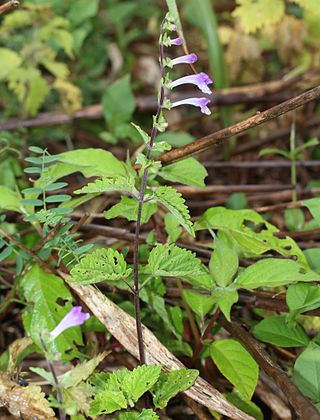
Scutellaria is a genus of flowering plants in the mint family, Lamiaceae. They are known commonly as skullcaps. The generic name is derived from the Latin scutella, meaning "a small dish, tray or platter", or "little dish", referring to the shape of the calyx. The common name alludes to the resemblance of the same structure to "miniature medieval helmets". The genus has a subcosmopolitan distribution, with species occurring nearly worldwide, mainly in temperate regions.
John Burns is an entomologist, curator of Lepidoptera and professor at Department of Entomology, Smithsonian Institution.

Centrosema, the butterfly peas, is a genus of American vines in the legume family (Fabaceae). It includes 44 species, which range through the tropical and warm-temperate Americas from the southern United States to northern Argentina. Species include:
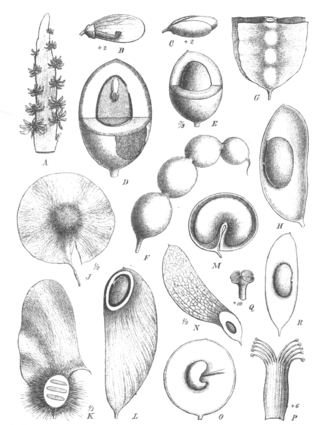
Lonchocarpus is a plant genus in the legume family (Fabaceae). It includes 166 species native to the tropical Americas, tropical Africa, and Madasgascar. The species are called lancepods due to their fruit resembling an ornate lance tip or a few beads on a string.
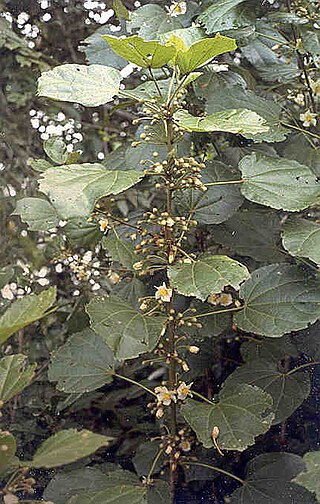
Hampea is a genus of flowering plants in the family Malvaceae. They are trees native to Mexico, Central America, and Colombia. There are about 21 species.

Capparis is a flowering plant genus, comprising around 250 species in the family Capparaceae which is included in the Brassicaceae in the unrevised APG II system. These plants are shrubs or lianas and are collectively known as caper shrubs or caperbushes. Capparis species occur over a wide range of habitat in the subtropical and tropical zones.
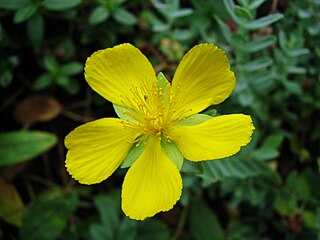
Hypericum olympicum, commonly known as the Mount Olympus St. John's wort, is a species of flowering plant in the family Hypericaceae found in the Balkans and Turkey and introduced to western Europe. It has been widely cultivated for centuries because of its large, showy flowers, which are far larger than those of most other species in Hypericum.
Silene jenisseensis, is a species of flowering plant in the family Caryophyllaceae, native to Siberia, Far East and Mongolia.

Winifred Hallwachs is an American tropical ecologist who helped to establish and expand northwestern Costa Rica's Área de Conservación Guanacaste (ACG). The work of Hallwachs and her husband Daniel Janzen at ACG is considered an exemplar of inclusive conservation.
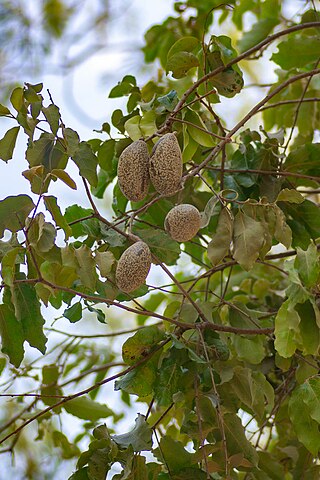
Licania pyrifolia, commonly known as merecure, is a species of flowering tree in the family Chrysobalanaceae. It has large green fruits, similar in size to the avocado, greenish with whitish freckles. It is widespread in the Llanos or Great Plains of the Orinoco river. The fruit is edible and it used to be planted near the Fundos for shade because it is evergreen and because of its fruit. It contains compounds that can be used to control snails and other mollusks harmful to crops. Its Latin name alludes to its leaves being similar to those of the pear tree. It is the flagship tree of the state of Apure in Venezuela.

Ploiarium is a genus of three species of woody plants in the family Bonnetiaceae. It is native to tropical forests and peat swamp forests in Southeast Asia including southern Indochina, Malay Peninsula, Sumatra, and Borneo. Species are generally slow growing with irregular flowering and fruiting cycles. Colonization of plants by arbuscular mycorrhizal fungi is known to improve growth and biomass.

Boscia angustifolia is a shrub or small tree with lanceolate leaves commonly found in the savannah zones of Africa, from Senegal moving eastwards to Sudan. It is part of the Capparaceae family. The plant is also known as the rough-leaved shepherds tree.
Cola rostrata is a species of flowering plant in the family Malvaceae, commonly known as monkey cola or cockroach cola. It is a tree found in the tropical rainforests of Cameroon, Nigeria and Gabon.
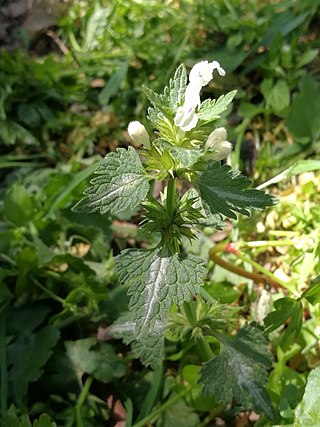
Lamium bifidum is a species of flowering plant in the mint family Lamiaceae, native to the Southern Europe. It was first described by botanist Domenico Cirillo in 1788.


















